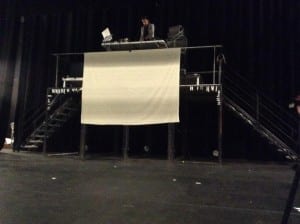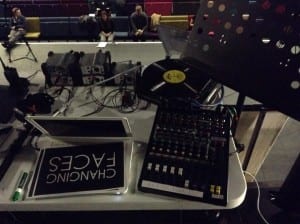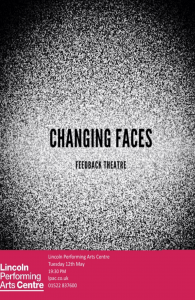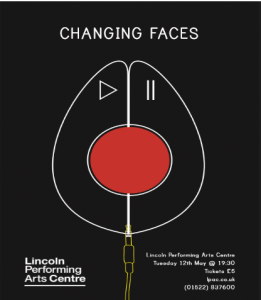From the beginning…
As we entered our final semester of university and sequentially the module ‘Multimedia Performance’ we were given the task of producing an ensemble performance using the various technologies we had available. A prospect that was both exciting and challenging. Our progress began with an introduction to the role of multimedia and digital technology in the world of theatre, and how it can be used as an important tool to enhance theatrical performance. Some examples of this technology is;
• Cameras
• Microphones
• Projections/Screens
• Computers
• Televisions
• Tripods and other equipment
• Speakers
These along with many more have become popular tool in theatre to create a variety of different effects. Continuing on our course we were also introduced to examples of theatre companies who adopt the use of multimedia technology into their performances. Theatre companies like ‘Gob Squad,’ ‘Blast Theory’ or ‘Proto-Type’ where the use of multimedia technology plays an integral role in performance. ‘Super Night Shot’ by ‘Gob Squad acts as a great example of how the multimedia technology can effectively effect the perceptual experience of theatre. With actors going out and filming their ‘adventure’ in the town an hour before the start of the show, and then presenting that film in the theatre as a way of distorting the perceptual experience of theatre. The camera also adds temporal and spatial elements to the performance, as these can be presented incoherently and expansive, for example in ‘Super Night Shot’ the temporal element is shifted and disjointed as the performance is presented an hour after its filmed. Furthermore the camera expands the stage into the streets as the audience sit in the theatre, watching the projections of the actor’s endeavours. This provided food for thought as there is really no end to the possibilities of using modern technology in performance.
Personally I feel that learning about these theatre companies who use multimedia technology in their work, and a showcasing of these pieces was undoubtedly an important part of this process, as they influenced the ideas that would later become the framework for our performance.
‘Jog Shutter’ Blast Theory 2013
‘Super Night Shot’ Gob Squad 2003
Our first step was deciding what equipment we wanted to use, considering were doing ‘Multimedia Performance’ this is obviously an important decision. Having learnt about the technology available to us throughout the course we decided that we wanted to use a variety of different tech in performance, so that it would be more tech based rather than performance. The technology we decided to use in the performance was;
• Camera
• Projection/Screen
• Tripod
• Television
• Microphone
• Laptop/Soundboard
• Record Player
• Visual Mixer
• Smoke Machine
With a great range of tech behind us, all we needed was to develop some material that could be used collaboratively with the technology to begin to create our performance and so the research and development stage started.
The Research
During the beginning stages of development, it became apparent throughout the group that we were all equally concerned with how technology effects our daily lives, and ideas about the future stemming from a quote from William S Burroughs “When you cut into the present, the future leaks out.” (Robinson) With this in mind we began thinking about totalitarian societies and ideas began to form about creating a dystopian world were this could be represented. This then became too complicated and complex with too many clashing ideas in terms of a set narrative or a story line. This is where our process lacked the focus and energy it needed to really get going. Ultimately we decided to strip it back to what we first interested about, the effect digital technology has in our every-day lives and how it can be used to change or represent a variety of different things.
With this in mind we began thinking about how we could use the technology alongside performers to represent significant moments in history. With the ultimate goal of communicating how important technology is within our society, how it’s used to report and represent significant events that occur but also to show how changing the use of the technology can drastically effect the original connotations of the event. This is where our research into the historical events began, as we began to think about how we could use this technology to represent these events on stage, through clever camera trickery or projections. This idea became attractive to all of us through the variety that it offered. As Scheer points out “multimedia performance is not confined only to performance that occurs in the virtual realm.” (Scheer 2012 p17) and so we knew wanted to utilize both the live and the mediated in order to represent these historical moments. Also as we were covering a lot of areas in small segments, it reduced the conflict in ideas that was present at the beginning of the process.
Each member of the group individually researched different historical moments and events that have been significant throughout history so that we developed a furthered understanding in those areas, and so that we had a myriad of topics to choose from in order to begin rehearsing around. The areas of research that we used were;
• The Big Bang Theory
• Winston Churchill
• Queen Elizabeth’s coronation
• The Wright Brothers first flight
• Suffragette movement
• Moon Landing
• Columbine Shootings
• Anne Frank
• Aids
• Assassination of JFK and Lincoln
Understanding these events was crucial in our attempt to recreate them as we wanted our audience to not immediately recognize what we were representing. Which requires a developed understanding of the context of these events as we were keen to try and stay away from clichés and the obvious as much as possible.
Get Developing!
The rehearsal schedule was implemented so that we would be focused and able to maximize our time before the performance. We began experimenting with the historical moments we had researched, using simple movements from live bodies in the space, for example walking in slowly and then sitting down. Then coupling this simplicity with the digital technology we had in order to combine them, representing the historical moment. For example we thought it would be effective to represent the aids epidemic through a re-creation of the last photo taken of Freddie Mercury. Bay Cheng notes that “Throughout the history of the arts and media, different disciplines have worked together in a range of combinations.” (Bay Cheng 2010) With ideas in mind influenced by ‘Proto-Type’ theatres ‘Virtuoso’ about using the camera in certain positions to create a new image on the mediated screen, we began experimenting with this.
We found that by having a camera centred downstage facing the stage, then placing an actor and objects on stage, we could re-create the picture, within the frame of the camera, so that the mediated image mimics the real. For example Georgie walked on as Freddie, then an image is projected behind her to make it seem as if she is standing outside. Then various items like flowers, or the chequered shirt are brought on, one by one by different performers who stand in certain positions so that when the camera faces it, the mediated image from that camera is almost exactly the same as the real picture. This creates something visually engaging to watch as the audience get to see the image manifest itself right before their eyes. However this was a scene that we found difficult to rehearse as we were unable to rehearse in the auditorium until a day before, meaning that until then we had no idea where the performers would stand in order to make the image.
We wanted the audience to be able to see the various pieces of technical equipment that we were using throughout the performance. We wanted them to see camera’s being moved around to create certain shots, breaking the fourth wall of performance. We also wanted to take this further and have scaffolding set up in order to show the tech desk on stage raised up above the performers, however we could not source transport for the scaffolding and so used stage platforms instead. The effect of having the technicians visible throughout the performance was important as they present the power and control they have during the performance. For example when Jack manually switches the sound cues and volumes, which can be seen visually through the television. Which reinforces our initial goal of communicating how much control technology has on our society.
Here are some images of the tech desk from rehearsals.
Tech Desk
Tech Desk
Furthermore during development of the ‘Moon Landing’ segment, we were faced with the challenge of representing the moon landing on stage. Initially this began with Jake and myself off stage giving our speeches about the moon landing. With only the cameras on our back in specific locations so that you can’t tell who it is and the identity becomes distorted. However we changed our minds because we ultimately thought it would be more effective to have us standing onstage saying our speeches directly into the camera. As we are obstructed by the tripods and camera operators in the live space, the audience is forced to look at the mediated images of Jake and me, effectivelysetting up the framework for the performance.
During this scene I was playing the role of JFK and was given the ‘Rice Texas’ speech that he originally gave in 1962. The decision was made that I would not be acting as if I were JFK, as we were not trying to re-create these historical moments and so an American accent and characterization was not needed. Rather I would speak the words with clarity and precision to represent the value of that speech and its historical context. The fact is the power and velocity those words have are evident through the text itself. Through experimentation we then found that these words spoken with clarity and precision into the camera then in turn projected onto the screens, created something visually engaging. It was then a case of adding in the other movement with the ‘office’ workers to start the performance who would act as a visual representation of when we landed on the moon. Then the music and the projection of moon landing images were also added to showcase the heavy use of tech in the performance and make this apparent from the start.
During the performance I also participated in the ‘Wright Brothers,’ ‘Assassination,’ ‘Columbine’ and ‘Big Bang’ scenes. Therefore throughout the rehearsal stage I also had a hand in the development of these scenes. Even though these scenes had a slow start to their development as a group, we were happy with the way they were presented in the performance. The heavy use of multimedia technology that was used in these scenes meant that it was difficult to rehearse them when the tech was not available. Nevertheless these segments of the performance developed in a similar way to the rest of the show. With initial ideas about staging the scenes being taken and experimented with in the space to discover what looks good and what doesn’t. This became a collaborative process with all members of the group involved in the development of the finished show. For example everyone present in rehearsals would watch a scene being developed, and be able to offer comments about what they think looks good or bad and also suggesting completely new idea’s entirely. This gave the entire group an element of control over what we were making which ultimately increased the bond between us as a group as everyone was aware that their opinion was important.
Towards the end of the rehearsal period this bond grew stronger and stronger as we grew closer to the performance date. Despite a slow start to our development, we pulled together towards the end and everyone was beginning to feel a sense of pride over what we had created. As the performance drew ever closer, we released our teaser poster and flyers to appropriately advertise our show.
Marketing
As a member of the marketing team I was given the task of creating the designs for the poster and flyers. We knew that we wanted the design to be simple, eye catching and relating to the performance. However we did not want the designs to give too much away and so the decision was made to keep the images simple. With this in mind I began to create sample images for the poster that I then showed the group, who voted on the one they liked the best.
For the main poster I simply put our performance name ‘Changing Faces’ in front of an image of static. This image was just what we needed, simple and eye-catching, whilst the static still alludes to several things used in the performance, possibly the most obvious being the television screen or cameras. The LPAC logo and details were then edited in after the initial image had been finalised by the group.
Sample Poster
Sample Poster
Final Poster
The flyer design was also created by me and followed in a similar path to the development of the posters. After having a chat with the directors about what theywanted for the flyer design I was given instruction to design something that was engaging enough to want to pick up. So with this in mind I began creating sample images for the flyer designs. I wanted the image to be simple, but stand out, so I decided to create images from minimal coloured lines on a black background. After showing these samples to the group I received positive feedback and a decision was then made about which one should be printed out to use.
Sample Flyer
Sample Flyer
Final Flyer Design
Performance Reflection
The performance gathered a reasonable audience turn out and personally I feel like it went well. The tech cues were all on time and the majority of the lines were spoken correctly. According to audience feedback the performance offered scenes that were visually engaging and beautiful for example, the ‘Big Bang’ scene where all the performers held up small torches in the darkness to create a constellation. Or the ‘Wright Brothers’ scene where the cameras faced Jake and myself as he folded paper airplanes and I sketched designs for ‘Kitty-Hawk,’ contrasting the images between the live space and the mediated image. However personally I feel like the performance had room for improvements.
After receiving some audience feedback about the performance we realised that what we were trying to achieve might not have been obvious all the way through. As if an audience member was unable to understand which historical moments we were trying to represent, the performance begins to not make sense. With further development we all liked the idea of implementing a single piece of text that would run through all the scenes in the performance, binding it together and making sure our goal of commenting on the ubiquity of technology in the twenty first century was not lost. Furthermore I also feel like more time in the space would have allowed the performance to be polished out and look more professional. There were times during the scene transitions that could have been cleaner and more precise, if rehearsed for longer. Nevertheless I feel that on the whole the performance was fantastic and the course of this development has truly been an unforgettable experience.
Works Cited
Blast Theory. (2013). Jog Shutter. Available: http://www.blasttheory.co.uk/projects/jog-shuttler. Last accessed 24th May 2015.
Edward S Robinson (2011). Shift Linguals: Cut-up Narratives from William S. Burroughs to the Present. Amsterdam: Routledge. p41.
Edward Scheer (2012). Multimedia Performance. Basingstoke: Macmillan Publishers. p17.
Gob Squad. (2003). Super Night Shot. Available: http://www.gobsquad.com/projects/super-night-shot. Last accessed 24th May 2015.
Sarah Bay Cheng (2010). Mapping Intermediality in Performance. Amsterdam: Amsterdam university Press. p15










